2025.02.20

“I want visitors to go home with an amazing experience,” says the director of the Nikon Museum. Let’s take a look and see what surprising new findings await us!

Known as something of a sacred site for camera buffs, the Nikon Museum was reopened in Nishioi in Tokyo’s Shinagawa-ku in October 2024. The museum was initially opened in 2015 in Minato-ku, where Nikon’s head office was then located, as part of the company’s centennial celebrations. As many as some 190,000 people in total had visited the museum at that location before it closed its doors at the end of February 2024. The popular museum was then revamped and reopened with a view to offering visitors hands-on visual and tactile experiences along with a record of the history and progress of Nikon’s advanced technologies, which have contributed not only to the evolution of the camera but also to industry and people’s lives. The new museum thus provides substantial content but charges no fee for admission. As such, the museum has already become a new landmark of Nishioi.
The floor area is roughly 1.3 times larger than before to allow the museum to share more stories about Nikon’s products and technologies!
“The new Nikon Museum is designed to be a place where visitors can experience the products and technologies that symbolize Nikon’s more than 100 years of tradition and innovation, along with the ideas behind them,” says museum director Yoshimasa Nakajima. Compared with the old museum in Minato-ku, the floor area has been expanded roughly 1.3-fold in order to display around 1,300 products in a space that extends over around 670 square meters. The museum is divided into the following four zones: the “Entrance Zone,” “Industry (B to B business) Zone,” “Consumer (B to C business) Zone” and “Theater Zone.”
“Nikon has built a tradition of manufacturing products with ever higher reliability and quality to deliver innovative products with the power to change the world,” Mr. Nakajima continues. “Wanting to communicate this clearly to visitors to the revamped museum, we have newly included with our product and technology displays some of the stories behind the development activities along with some inside stories and some other tidbits that testify to our strong commitment to high-quality manufacturing.”
These stories are introduced alongside Nikon’s advanced technologies in a creative manner. Former director of the museum Hidenobu Kaji, who now works for Nikon Museum, the Corporate Communications Department in Corporate Strategy, explains: “By scanning the QR code shown for a specific display, visitors can access the museum’s official Instagram account to read a story about the display. They can also choose explanations they want to read from among the display options shown on the on-site touchscreen monitor. The museum also has a large “Touch & Try” space where visitors can experience Nikon’s advanced technologies by actually handling the equipment that incorporates the technologies. This space is highly rated by visitors.”
Showcasing the leading-edge B-to-B technologies that have contributed to the development of industry in an easy-to-understand manner

In the Industry Zone, Nikon’s products and technologies that have contributed to the development of various industries are displayed alongside a synthetic silica ingot symbolizing Nikon’s technological prowess.
In the Industry Zone, which is located near the entrance, a range of Nikon’s B-to-B products and technologies are displayed, including semiconductor lithography systems, flat panel display (FPD) lithography systems, microscopes, astronomical telescopes, optical processing machines, measurement instruments and inspection instruments.
“Nikon tends to be regarded as a camera manufacturer. Looking back on its history, however, the company has been manufacturing B-to-B products longer than it has cameras, engaging in a broad range of business fields,” explains Mr. Nakajima. “At the museum, we have classified Nikon’s technologies and products into four groups by using four familiar verbs—“Utsusu” (project/expose), “Miru” (inspect/observe), “Hakaru” (measure) and “Tsukuru” (manufacture/create)—in order to show them to visitors in a more intuitive and intelligible manner.”
One example is the measuring and surveying instruments, which used to feature crosshairs made with silk from the joro spider. Visitors can view a display that tells an impressive story about the spiders being raised at the Oi Plant. They can also try their hand at measuring various things using an instrument that offers micron-level precision. The sheer breadth and depth of Nikon’s technologies, which are not limited to those related to cameras, are sure to elicit exclamations of “Oh!” and “Wow!” from surprised visitors.
Cameras are displayed along 27-meter-long walls, and there are also cameras that visitors can touch, including some historically valuable ones.

Consumer Zone, where impressive displays of cameras line the walls
At the revamped museum, the display of cameras has of course been improved as well. Along the roughly 27-meter-long walls in the Consumer Zone, Nikon’s first camera, named the “Nikon Model I” (put on sale in 1948), and its first SLR camera, the “Nikon F” (1959), are displayed together with the company’s leading-edge digital cameras as well as past-to-present models of its full range of cameras and lenses, which have been used in a range of fields, from news reporting to space development. “The display space shows the long history of Nikon, and I think it is a great collection that everyone should see,” says Mr. Kaji. Visitors will no doubt be blown away by the number of products included and the impressive corporate history that they represent.
In the “Touch & Try” space, visitors can enjoy the rare experience of physically handling a selection of historically valuable cameras. You can even press the shutter to see how it feels to be a first-class photographer.
“My hope for the Nikon Museum is that camera lovers will find even more to love, commercial customers will expect even more from our trusted products, and Nikon employees will take even more pride in their company,” says Mr. Nakajima. “I also hope local residents and others will stop in for an amazing experience and will feel something new about the company while they’re here.”
Having an “amazing experience” means being struck by something new. A longtime resident of Nishioi expressed this very sentiment upon visiting the museum. “I was really surprised to learn that Nikon, a name that I have known for many years, manufactures so many different products,” the visitor said.
“Many of the visitors to the old museum in Minato-ku came for business purposes,” says Mr. Kaji. “Now that it has been revamped and reopened in Nishioi, I have maybe high hopes that people living in the area will visit the museum and help make it a popular local spot. We also often welcome retired Nikon employees and seeing them happily gaze at a device made by the company more than 50 years ago, I feel a strong sense of duty to keep the museum going for the next 50 or 100 years in order to pass this heritage down to the next generation.”
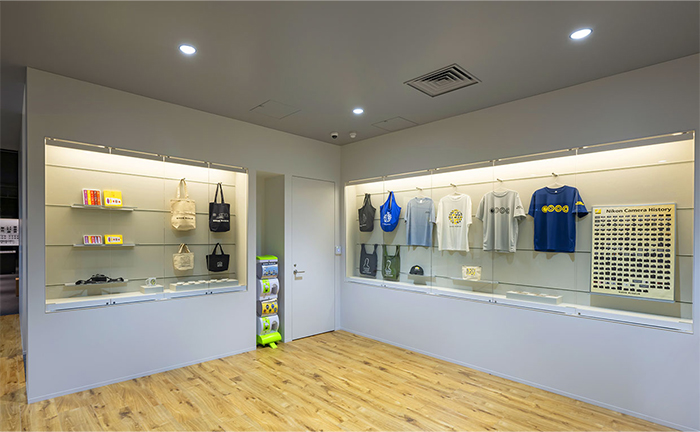
Museum shop on the premises
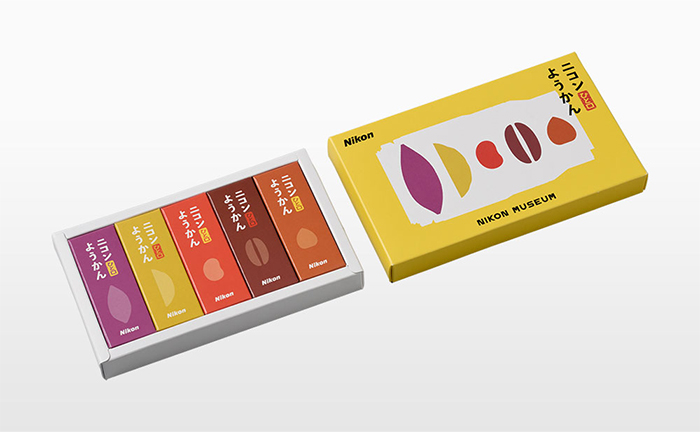
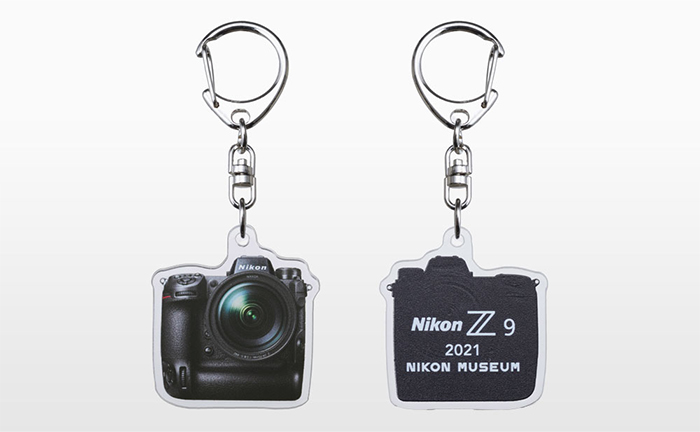
“Nikon mini yokan” and “Acrylic camera keychain”
The lineup of original goods sold at the museum shop has also been expanded. The popular “Nikon mini yokan” product (Japanese sweets made from azuki beans and sold for 1,400 yen, including tax, per package) was also updated by adding a coffee-flavored yokan to the conventional honneri, sweet potato, yuzu and Japanese chestnut assortment. The acrylic camera keychain products with designs featuring photos of cameras, lenses and others are priced at 500 yen each, including tax, and as many as 14 different designs are available. Capsule toys (pinback buttons) are also popular.
With the Nikon Museum having thus made a promising fresh start, Mr. Nakajima is committed to its continued advancement.
“When Nikon marked the centennial of its founding, I worked on the creation of a booklet on the annals of the company,” he says. “Learning more about Nikon’s long history convinced me that it really is a good company and I wanted more people to be aware of Nikon’s intergenerational commitment to high-quality manufacturing. By revamping the museum, I was able to make this a reality. I now feel like I have assumed a big responsibility to communicate Nikon’s identity in Nishioi, a place that is deeply connected to the company’s history. Taking pride in the company’s 100-year track record, I would like to communicate its history of tradition and innovation and develop the museum further in cooperation with the local community in my capacity as a corporate citizen.”
The Nikon Museum is planning to hold special exhibitions as well as events for children.
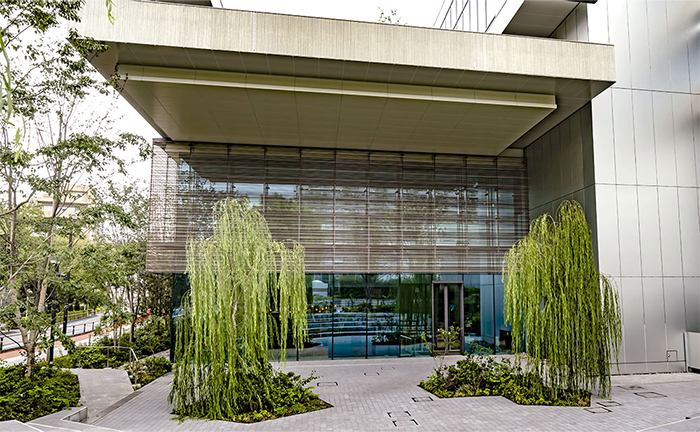
Entrance to the Nikon Museum (fitted with a ramp)
Nikon Museum
Location: 1-5-20, Nishioi, Shinagawa-ku, Tokyo 140-8601
Nikon Corporation Global Headquarters / Innovation Center 1F
Opening hours: 10:00 a.m. to 5:30 p.m. (last admission at 5:00 p.m.)
Closed: Mondays, Sundays, Japanese national holidays, and other days as determined
by the Museum
*Including national holidays that fall on Saturdays
*Closure or changes to the opening hours may occur, depending on weather and/or
public transport conditions.
Admission: Free
Contact:
Tel.: +81-3-6743-5600
https://www.nikon.com/company/corporate/museum/
INTERVIEWEES

YOSHIMASA NAKAJIMA
Director, Nikon Museum
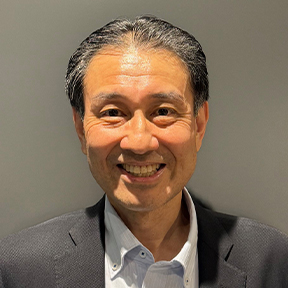
HIDENOBU KAJI
Nikon Museum, Corporate Communications Department, Corporate Strategy
Nikon Corporation
1-5-20, Nishioi, Shinagawa-ku, Tokyo
Since its founding in 1917, Nikon has been providing new value by exploring the possibilities of light. Aiming to “provide products and services optimized to meet our customer needs,” the company operates five businesses: the Imaging Business (cameras and others), the Precision Equipment Business (semiconductor and FPD lithography systems and others), the Healthcare Business (microscopes and others), the Components Business (optical materials and components) and the Digital Manufacturing Business (optical processing machines and others).
